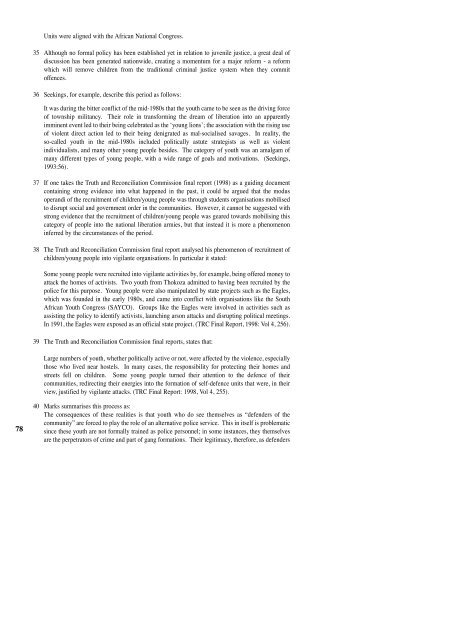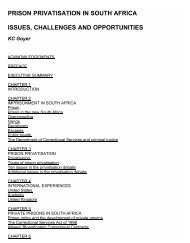Child Soldiers in Southern Africa
Child Soldiers in Southern Africa
Child Soldiers in Southern Africa
Create successful ePaper yourself
Turn your PDF publications into a flip-book with our unique Google optimized e-Paper software.
Units were aligned with the <strong>Africa</strong>n National Congress.<br />
35 Although no formal policy has been established yet <strong>in</strong> relation to juvenile justice, a great deal of<br />
discussion has been generated nationwide, creat<strong>in</strong>g a momentum for a major reform - a reform<br />
which will remove children from the traditional crim<strong>in</strong>al justice system when they commit<br />
offences.<br />
36 Seek<strong>in</strong>gs, for example, describe this period as follows:<br />
It was dur<strong>in</strong>g the bitter conflict of the mid-1980s that the youth came to be seen as the driv<strong>in</strong>g force<br />
of township militancy. Their role <strong>in</strong> transform<strong>in</strong>g the dream of liberation <strong>in</strong>to an apparently<br />
imm<strong>in</strong>ent event led to their be<strong>in</strong>g celebrated as the ‘young lions’; the association with the ris<strong>in</strong>g use<br />
of violent direct action led to their be<strong>in</strong>g denigrated as mal-socialised savages. In reality, the<br />
so-called youth <strong>in</strong> the mid-1980s <strong>in</strong>cluded politically astute strategists as well as violent<br />
<strong>in</strong>dividualists, and many other young people besides. The category of youth was an amalgam of<br />
many different types of young people, with a wide range of goals and motivations. (Seek<strong>in</strong>gs,<br />
1993:56).<br />
37 If one takes the Truth and Reconciliation Commission f<strong>in</strong>al report (1998) as a guid<strong>in</strong>g document<br />
conta<strong>in</strong><strong>in</strong>g strong evidence <strong>in</strong>to what happened <strong>in</strong> the past, it could be argued that the modus<br />
operandi of the recruitment of children/young people was through students organisations mobilised<br />
to disrupt social and government order <strong>in</strong> the communities. However, it cannot be suggested with<br />
strong evidence that the recruitment of children/young people was geared towards mobilis<strong>in</strong>g this<br />
category of people <strong>in</strong>to the national liberation armies, but that <strong>in</strong>stead it is more a phenomenon<br />
<strong>in</strong>ferred by the circumstances of the period.<br />
38 The Truth and Reconciliation Commission f<strong>in</strong>al report analysed his phenomenon of recruitment of<br />
children/young people <strong>in</strong>to vigilante organisations. In particular it stated:<br />
Some young people were recruited <strong>in</strong>to vigilante activities by, for example, be<strong>in</strong>g offered money to<br />
attack the homes of activists. Two youth from Thokoza admitted to hav<strong>in</strong>g been recruited by the<br />
police for this purpose. Young people were also manipulated by state projects such as the Eagles,<br />
which was founded <strong>in</strong> the early 1980s, and came <strong>in</strong>to conflict with organisations like the South<br />
<strong>Africa</strong>n Youth Congress (SAYCO). Groups like the Eagles were <strong>in</strong>volved <strong>in</strong> activities such as<br />
assist<strong>in</strong>g the policy to identify activists, launch<strong>in</strong>g arson attacks and disrupt<strong>in</strong>g political meet<strong>in</strong>gs.<br />
In 1991, the Eagles were exposed as an official state project. (TRC F<strong>in</strong>al Report, 1998: Vol 4, 256).<br />
39 The Truth and Reconciliation Commission f<strong>in</strong>al reports, states that:<br />
Large numbers of youth, whether politically active or not, were affected by the violence, especially<br />
those who lived near hostels. In many cases, the responsibility for protect<strong>in</strong>g their homes and<br />
streets fell on children. Some young people turned their attention to the defence of their<br />
communities, redirect<strong>in</strong>g their energies <strong>in</strong>to the formation of self-defence units that were, <strong>in</strong> their<br />
view, justified by vigilante attacks. (TRC F<strong>in</strong>al Report: 1998, Vol 4, 255).<br />
78<br />
40 Marks summarises this process as:<br />
The consequences of these realities is that youth who do see themselves as “defenders of the<br />
community” are forced to play the role of an alternative police service. This <strong>in</strong> itself is problematic<br />
s<strong>in</strong>ce these youth are not formally tra<strong>in</strong>ed as police personnel; <strong>in</strong> some <strong>in</strong>stances, they themselves<br />
are the perpetrators of crime and part of gang formations. Their legitimacy, therefore, as defenders
















